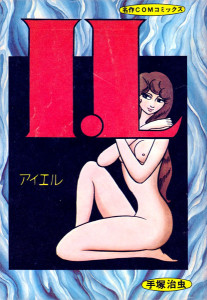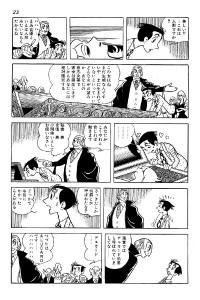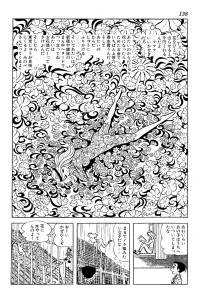I.L (Manga)
Also known as アイエル (Ai-el)
| English Title: | I.L |
| In English? | No |
| Japanese Title: | アイエル Ai-el |
| Type: | Chapter Serial |
| Original run: | 1969/08 – 1970/03 |
| Published in: | Big Comic ビッグコミック |
| Published by: | Shogakukan |
| Volumes: | 2 (MT-263 | MT-263) |
Following hot on the heels of Swallowing the Earth (1968-69), Tezuka’s next project, I.L (pronounced “Aye-El”), was originally serialized in Big Comic from August 1969 to March 1970. Published between Swallowing the Earth (1968-69) and Ode to Kirihito (1970-71), in many ways I.L bridges the gap between Tezuka’s early, somewhat frenetic, attempt at manga exploring more mature themes, and his later, more structurally complex, works.
What it’s about
Another of his stories featuring disguise and transformation, I.L focuses on the “death of the fantastic”. The story is centered around Imari Daisaku, a formerly successful but now unpopular filmmaker. Since the Apollo moon landings have proved the triumph of science over myth, Daisaku‘s films are now considered too fantastic and whimsical for the modern tastes of society.
Daisaku is lured into a mysterious mansion by a fortune teller, and there approached by a group of strange creatures led by Count Alucard – an anagram for “Dracula”. They tell Daisaku that they are impressed by the fact that he has held fast to the world of fantasy, despite the pressures of the modern scientific world, and that they want to support him. To this end, they grant him the mysterious “I.L”, a “not quite alive” mannequin in the shape of a young woman, who, after spending a few minutes sealed in her special coffin, is able to transform her shape to make herself look like anyone she wishes. And so, I.L and Daisaku start up a business to rent out I.L’s special shape-shifting abilities by having her stand in as a body-double for clients.
Each chapter, more or less, begins with a client contacting I.L and explaining their reasons for needing her to take their place. I.L’s impersonations have her standing in for people for reasons ranging from teaching an abusive husband a lesson, to helping a woman escape political oppression, to bringing closure to unrequited lovers, or taking the place of a store-front mannequin during an assassination attempt. While each chapter is a complete story unto itself, the overarching plot explores Daisaku‘s struggle to decide if he would rather believe in the cold world of science like his fellow man, or the strange and mysterious world of Count Alucard and his followers.
What you should know
After his experiences with Swallowing the Earth (1968-69), Tezuka decided to try a different approach with I.L. As he writes in the afterword of the Osamu Tezuka Complete Manga Works edition (MT-263), “From the start, I just let myself be completely swept away in my imagination, which resulted in a long serialization that I had a lot of trouble extricating myself from” (1982, p. 204). Given that the other works published in Big Comic were serialized as complete short stories, Tezuka felt that the quality of Swallowing the Earth (1968-69) was impacted by the fact that he left readers hanging week in and week out – ultimately making it less of a success than he’d hoped for.
As such, he structured the chapters in I.L around small “morality plays”, where I.L uses her abilities to right wrongs or teach others a lesson. Through the theme of transformation, a favourite of his, Tezuka was also able to explore such things as political corruption, the possessive nature of love, gender roles, and, much like his stories featuring robots, the nature of non-living people.
Finally, in an interesting case of grammatical error, the original title for the manga was suppose to be “I’L” (itself already a mistaken form of the contraction “I’ll” for “I Will”), however the printers made a mistake substituting a period (.) for the apostrophe (‘) and the result was I.L. In the end though, Tezuka decided to stick with it, and made it the name of his shape-changing female character.
What else you should check out
Check out the link below for chapter summaries and more detailed publication information on the I.L (1969-70) serialization in Big Comic .






